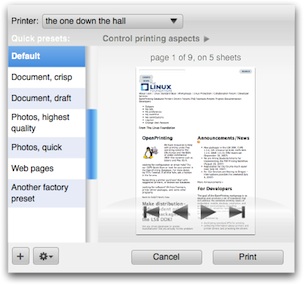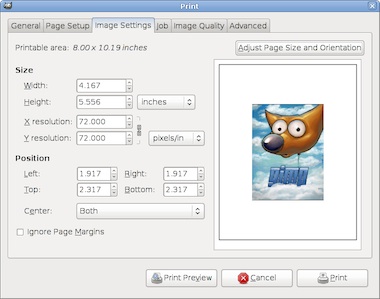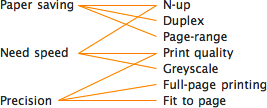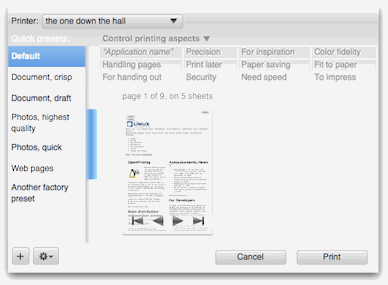to Istanbul via Tokyo
18 July 2008, 14:09
Last week I was on the road for openPrinting. First a couple of days in Tokyo to discuss with the Japanese printer manufacturers my printing dialog design. There was appreciation and encouragement, but the best news last week was that the printing dialog is scheduled to go in all major linux distributions next spring.
With that under my belt, I spent a couple of days in Istanbul for guadec, the GNOME developer conference. I did a presentation to raise awareness among developers for openPrinting.
the 8 rules of printing interaction
For my presentation I condensed the challenges, findings and solutions of printing interaction into eight rules:
1st rule of printing: printing does not exist
m+mi works’ partner company, relevantive, performed user research at the beginning of this project. It showed that for users there is no worthwhile, productive activity between the moment they want to see something printed and the moment it comes out of the printer.
Printing, like streetlights, is infrastructure and it just has to work. This has important implications as we will see.
2nd rule of printing: printing does not exist
When I got started on this project in October 2006, I evaluated all printing dialogs for GNOME, KDE, windows and OS‑X. The overall impression was one of stagnation, a time warp back to the mid‑nineties. Only OS‑X is inching forward, getting ahead of the others.
Since then I have learned where the stagnation comes from: no one can be bothered to do the development work. This ‘can’t touch this’ approach was again palpable at guadec. Delivering an innovative interaction concept has broken this negative spiral. Alex Wauck is developing my new dialog design, for GNOME and KDE at the moment.
3 levels of printing
Taking the paradox of the first rule to its logical extreme, we introduced three levels of printing.
- level 1
- Printing that just works. Users know for 90% of the printing they do that ‘it will be OK’ when done like last time. As the first—and probably most important—innovation in this project, we complement today’s Print… command with ‘Just Print’, which shows no dialog and prints using defaults and last used settings.
- level 2
- A basics level of involvement: what printer; maybe set a quick preset; check the preview; done:

- level 3
- Detailed. Parameter. Tweaking. It is ironic that within the openPrinting project we will spend most of our time, discussions and effort on covering this single last percent of usage.
4th. wysiwyg is overrated
There is no better way to derail a discussion about printing than by using the example of printing a word/openOffice writer file. These applications are one of the few out of tens of thousands where the data is already paper‐formatted on the screen. That takes our mind off an important part of the process.
Spreadsheets; web browsers; email; MP3 collections (iTunes); anything based on a database: all these applications will have to put their data through a transformation to get it on paper, when they print. This is exactly the point where application and printing infrastructure have to cooperate most.
5 million use cases
Being a generic piece of infrastructure, printing turns out to have as many use cases as there are users. Try to take the encyclopaedic route and map these out: you will go mad with an exponentially ballooning amount of variants.
Life is easier being a printer. Each model is made in relative limited numbers for a specific market. This focus is useful for the printing dialog design. But I can not run a design project saying ‘gee, everything depends on the printer model.’ So early 2007 we surveyed the printer market and formed the following printer clusters:
- personal laser
- workgroup laser
- high volume printers
- general inkjet
- photo printers
- wide format
- impact printers
This covers more than 95% of the market. I am in the process of designing a printing dialog for each cluster. Printer manufacturers can customise these best‐practice examples for their models.
6th. unknown: good printing dialog
What is the ideal layout for a printing dialog? I can tell you that only when I know the specific user’s goal (one of those five million), in the context of the application that is used and the printer that is targeted. Of all of us, only that specific user is present when these three meet.
The solution is user‐configured printing dialogs. Users shape the dialog so that they can achieve their goal for that print. The dialog configuration will be persisted as it was left, for the particular user + application + printer combination. It will be ‘just right’ next time that user prints from that application to that printer.
7th. tabs considered harmful
I am talking about the tabs, at the top of the dialog below, that segment the printing parameters into technical categories. Apart from the danger of separating parameters that were related or putting one in the wrong category—both from a particular user’ point of view—there is a more fundamental problem.

Assume six tabs as shown here. And the better‐than‐real‐life situation that all printing parameters are evenly distributed over the tabs and that users actually know where to find each parameter.
- is it not a pity to have to change tab once to set one parameter? there is a 83% that this occurs;
- is it not annoying to have to change tab twice to set two parameters? 75% chance;
- set three parameters, what is the worst that could happen? to have to change tab three times: still a 50% chance.
That is an untenable situation. Tabs work great in some situations—e.g. tabbed browsing, preferences dialogs—but not in a printing dialog.
8th. tags not tabs
The solution is to associate multiple printing aspects with each parameter instead of just one category. Tags instead of tabs:

As a result from rule five, this mapping will come from the printer
(

printing rules, OK?
Those are the 8 rules of printing interaction. Stay tuned for a small encore, the guadec special: what about pdf?
Labels: lecture, openPrinting, practical

2 comments · post a comment
- at 02 December, 2008 20:20, commented
- I find this project very exciting, the 'innovate' side of open source... would we be able to have an update on the progress to date?
I briefly chased around a few of the wiki's and mailing lists but other than 'stuff was done' it's hard to tell how far out we are from stuff we can use or preview (haven't broken down and downloaded code and compiled yet...) - at 12 October, 2010 08:01, commented
- Printing really needs to go away. I never want to print again. Instead, give me sheets of e-ink that I upload images to over HTTP.
If you like to ask Peter one burning question and talk about it for ten minutes, then check out his available officehours.
What is Peter up to? See his /now page.
- info@mmiworks.net
- +49 (0)30 345 06 197
- imprint


 Peter Sikking
Peter Sikking